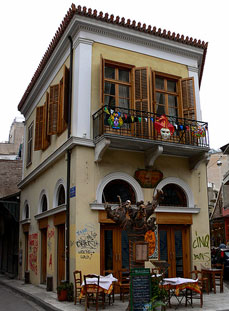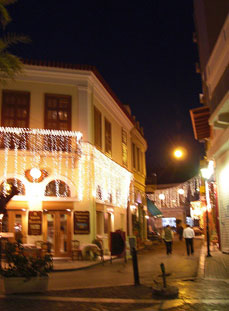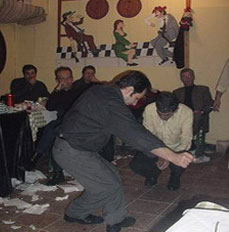


Athens Psiri District
There is much debate on the origin of the name of this district, Psyrrios. It probably derives from the name of a rich family that owned land in the area. It could also come from the Greek word for lice (pseires) in that the cleaner upper classes of Athens during the Ottoman period lived within the confines of the Late Roman Fortification wall to the southeast and those of the lower, therefore, dirtier, lice-prone classes lived in this area outside the protective walls. Take your pick.
In antiquity the deme of Skambonidai occupied this part of the city. This and Plaka are the only districts of modern Athens which retain some of the characteristics of the town during the Ottoman period, when some of the most important families of Athens lived here. After the War of Independence this district evolved into the area where revolutionary veterans and economic immigrants from the provinces came to live. Some, especially craftsmen, were able to struggle and succeed in business. They had simple shops and lived above them. As many were unemployed and poor, they sought whatever work they could find to support themselves and their families. Consequently, various forms of crime became their primary means of livelihood. These nefarious activities included the extortion and protection rackets within the city using whatever physical violence was needed to secure their dominance and illegal reward. Successful criminals and their henchmen dressed in expensive and outlandish ways, in order to show people how important they were as entrepreneurs. These men were called Manges tou Psyrri, or trabucci, after the type of cigarette they smoked incessantly. In 1893, during Charilaos Trikoupis' administration, the police finally broke their reign of crime and made the place safe for the district's poor. Later, many people from Naxos in the Cyclades emigrated here.
The core of this low-lying district, to the north of Monastiraki and to the west of the Historical Center, never had a public building built here before World War II. As this was always a district inhabited by the poor of the city, during the war they were supporters, in general, of the Communist partisans, the National Popular Liberation Army (ELAS), against the German occupation. When the Dekemvriana revolt started in December 1944, the leftist residents of the district were active participants in the fighting. They saw their district as the only place remaining which was controlled by the Left and, thus, called it Free Athens. With the British forces occupying Monastiraki and the Acropolis, as well as the rightist/monarchist forces ensconced above in Theseion, the two allied forces threw a rain of fire on the defenders in Psyrri until they surrendered or fled. The many churches of the district served as makeshift hospitals for the wounded in this vicious civil war.
Today it is a gritty, edgy and avant-garde place. Along its narrow, rabbit warren of streets is a rough, mismatched juxtaposition: early 20th century humble working-class, now seedy, houses; ugly, tall and dirty modern commercial buildings; restored (often with gaudy colors and questionable details), older houses and buildings for use as unusual restaurants, trendy cafes and ouzeri, outlandish clubs or intimate chic wine bars. Set among this odd mixture are antique shops, art galleries featuring contemporary arts and boutiques with fantastic clothing. Some see this district as the Athenian equivalent of Soho, the home of action - artistic and otherwise - as compared to the materialistic yuppiness of many other parts of the city (especially Kolonaki) and the suburbs. This area is either liked or disliked intently!
